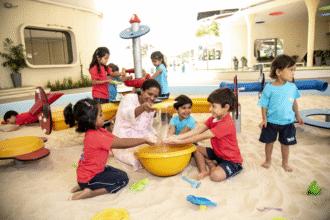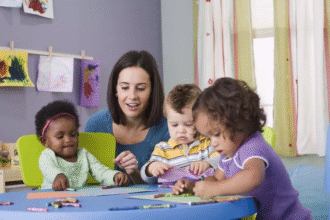Choosing the right child care center is one of the most important decisions parents make. After all, your child’s safety, happiness, and development depend on it. Whether you’re returning to work or simply looking for a place where your child can grow and socialize, it’s essential to have a clear checklist to guide your decision. This article will help you know what to look for when evaluating a new child care center so you can feel confident and at ease with your choice.
Why Having a Checklist Matters
A checklist keeps you focused on what truly matters. It’s easy to get distracted by cute decor or friendly staff, but a deeper look can help you evaluate whether a center meets your expectations. You want to ensure that your child is not only safe but also emotionally supported and intellectually stimulated.
Complete Checklist for Evaluating a Child Care Center
Here’s a complete, easy-to-follow checklist for evaluating a new child care center:
1. Licensing and Accreditation
- Is the center licensed by the state?
- Does it have any national accreditations (like NAEYC or NECPA)?
- Are all teachers and caregivers certified in CPR and first aid?
Why this matters: A license ensures the center meets basic safety and care standards. Accreditation adds a level of quality assurance.
2. Safety and Cleanliness
- Are doors locked and secured to keep strangers out?
- Are toys and play areas clean and well-maintained?
- Is there a clear process for checking in and out?
Why this matters: You want a safe and healthy environment. A clean center reflects care and professionalism.
3. Teacher Qualifications and Staff-to-Child Ratio
- What is the teacher-to-child ratio?
- Are staff members trained in early childhood education?
- Is there low staff turnover?
Why this matters: Experienced and stable staff create a loving and structured environment. A good ratio ensures your child gets enough attention.
4. Daily Schedule and Activities
- Is there a structured routine with time for learning, play, meals, and rest?
- Are the activities age-appropriate and engaging?
- Is there a balance between indoor and outdoor time?
Why this matters: Children thrive with routine and stimulation. A strong curriculum promotes emotional and mental development.
5. Nutrition and Meals
- Are meals and snacks provided?
- Are they healthy and nutritious?
- Can the center handle allergies or special diets?
Why this matters: Good nutrition helps children grow and concentrate. It’s also important that the center respects dietary needs.
6. Communication with Parents
- Do they provide daily or weekly updates?
- Is there an app or platform for communication?
- Can you easily talk to your child’s teacher?
Why this matters: Strong communication builds trust and keeps you involved in your child’s daily experience.
7. Emotional and Social Environment
- Do the children seem happy and engaged?
- Are teachers warm, caring, and attentive?
- How do staff handle discipline and conflict?
Why this matters: A positive atmosphere helps your child feel safe and confident. How conflict is handled shapes behavior and self-esteem.
8. Health Policies
- What is the sick child policy?
- How do they handle injuries or emergencies?
- Are vaccinations required?
Why this matters: Clear health policies keep your child safe from illness and ensure quick response in case of accidents.
9. Learning Materials and Play Areas
- Are there books, puzzles, art supplies, and sensory toys?
- Are outdoor play areas safe and stimulating?
- Are materials rotated to keep children engaged?
Why this matters: Quality materials encourage creativity, problem-solving, and fine motor skills.
10. References and Reviews
- Can they provide references from other parents?
- What are online reviews like?
- Are there any complaints filed with licensing boards?
Why this matters: Hearing from other parents gives you honest insight into what to expect.
How to Use This Checklist
Take a printed copy with you when visiting the child care center. Walk through each item and check off what you observe. Don’t be afraid to ask questions, request documents, or even schedule a second visit. Remember, you are your child’s voice and advocate.
Red Flags to Watch Out For
While touring a center, watch out for these warning signs:
- Unhappy or withdrawn children
- Rude or inattentive staff
- Dirty facilities
- High staff turnover
- Lack of transparency or unwillingness to answer questions
These are signs that the center may not provide the level of care your child deserves.
What to Do After the Visit
Once you’ve visited a few centers:
- Compare your checklist results.
- Talk with your partner or trusted family members.
- Trust your gut feeling—if something doesn’t feel right, it probably isn’t.
- Do a trial day if the center offers it. See how your child reacts.
- Ask for updates after the first few days to ensure a smooth adjustment.
FAQs:
1. How do I know if a child care center is licensed?
You can ask the center directly or check your state’s Department of Human Services website, which usually lists licensed centers and any inspection reports.
2. What is a good teacher-to-child ratio?
For infants, a 1:3 or 1:4 ratio is ideal. For toddlers, 1:5 or 1:6. For preschoolers, 1:8 or lower is best. The smaller the ratio, the more attention your child will receive.
3. Can I drop by the center without notice?
A good center will allow unannounced visits (within reason). This shows transparency. However, during nap times or certain activities, they may limit disruptions.
4. Should I worry if my child cries when I leave?
It’s completely normal for children to cry during the first few days. Most children adjust within a week or two. Ask the staff how long the crying lasts and how they comfort the child.
5. Is it okay to ask other parents about their experience?
Absolutely! Talking to current or past parents gives you a real sense of what the day-to-day is like. Most parents are happy to share honest feedback.
Final Thoughts
Choosing a child care center isn’t just about convenience or cost—it’s about trust. You’re handing over the care of your little one to someone else. That’s a big deal. By following this checklist, you’re taking an active role in making the best decision for your family. Every child deserves a safe, happy, and enriching place to grow.






